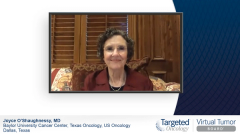
Case 1: DESTINY-Breast01
Experts discuss the treatment considerations for HER2+ metastatic breast cancer and provide an overview of the DESTINY-Breast01 trial.
Episodes in this series

Joyce O’Shaughnessy, MD: I was curious that the NCCN [National Comprehensive Cancer Network] Guidelines had shown, putting CLEOPATRA first, showing a big survival advantage. When it came to second-line treatment, this patient got T-DM1 [trastuzumab emtansine], which is a typical thing for patients to get. But the NCCN Guidelines didn’t say second-line T-DM1 [trastuzumab emtansine] and then third line, here’s a menu. What was the thinking around that? People don’t have to be wedded to T-DM1 [trastuzumab emtansine] second line, do you think?
William Gradishar, MD: No, the sentiment is that T-DM1 [trastuzumab emtansine] would be the second line, based on data we have. Hold your powder or keep your powder dry, as the saying goes, because the next update, which will be in a few weeks, is going to categorize what you’re suggesting: what is recommended first, what is recommended second, and what is recommended third rather than having this huge box that has 15 options.
Mark Pegram, MD: In that regard, Joyce, the label language for tucatinib is second line or greater.
Joyce O’Shaughnessy, MD: We do have a choice. We’re going to get into that because we’re going to talk about some cases with brain metastases. Should we go looking for brain metastases so we can give tucatinib to those who have them? We’ve got T-DM1 [trastuzumab emtansine] labeled second line or later, and we’ve got tucatinib second line or later. We’ll see what the NCCN does with those options for us. Adam, this patient has benefited from T-DM1 [trastuzumab emtansine], but she’s progressed in her liver. How do you think through the options for her? How do you prioritize things for her?
Adam Brufsky, MD, PhD: We have some data to help us, and we’ll show them in the next couple of slides. This is NCCN, and yes, we have to hold our powder because this is going to change. Bill, you’re going to have a first-line, second-line thing? Is that how it’s going to go?
William Gradishar, MD: That’s correct. That’s right.
Adam Brufsky, MD, PhD: That’s great. But you can see, before we’ve done this, a broad variety of preferred regimens. A lot of the category 1s, though, are shown up at the top. The preferred regimen is pertuzumab-trastuzumab-docetaxel in the first line, which this patient received. Then there’s some good phase 2 data from Memorial Sloan Kettering [Cancer Center] of pertuzumab-trastuzumab-paclitaxel, and it gets supported by some other data that have come out over the last couple of years in various means. There are also other recommended regimens. These are generally later line. There’s tucatinib-trastuzumab-capecitabine, T-DM1 [trastuzumab emtansine], and trastuzumab deruxtecan–trastuzumab-paclitaxel-carboplatin. These are some things we used to use before we had newer agents: trastuzumab-docetaxel, vinorelbine-capecitabine. We’re going to get into some of these over time.
The question becomes how to sequence them and how to put them in order. Most of us in the first line would do a CLEOPATRA-like regimen. There’s a survival benefit. Most of us, at least until very recently, would have used T-DM1 [trastuzumab emtansine] as a second-line because of the survival benefit. But the real question is what do we do third line. This shows you trastuzumab deruxtecan is an ADC [antibody-drug conjugate], which is a humanized anti-HER2 [human epidermal growth factor receptor 2] IgG1, which get into the vagaries of the immune response. We’ve all become immunologists over the last year, but IgG1 tends to add the TH1 [T helper type 1] response, which is what you want against tumors. It’s the same amino acid sequence as trastuzumab, but it is a biosimilar. There’s a topoisomerase inhibitor payload, an exatecan derivative, and a tetrapeptide-based cleavable linker.
The nice thing, and the things that make this unique, are the antibody-to-drug ratio, which is approximately 7.8:1, whereas T-DM1 [trastuzumab emtansine] is 3:1. Additionally, you have the cleavable linker, whereas T-DM1 [trastuzumab emtansine] has a noncleavable linker, so this allows some of the bystander effects of the antibody. One would expect potentially to have more efficacy than the first-generation T-DM1 [trastuzumab emtansine].
This shows you the phase 2 DESTINY-Breast01 study, which was published in the New England Journal of Medicine over a year ago. It was presented at San Antonio [Breast Cancer Symposium] 2019. What you can see is that with these women, this is a combination of dose escalation part 1, a dose-finding part 1, and then a continuation part 2. In this, there was a total of 184 patients enrolled at a 5.4-mg/kg dose. The patients were 18 years or olderand had unresectable or metastatic breast cancer. It was HER2, centrally confirmed. They had to have prior T-DM1 [trastuzumab emtansine]. If you had significant interstitial lung disease you were excluded from the trial. You could have stable treated brain metastases; it was about 5% or so. It was somewhere in the 20s or 30s in terms of patients who had brain metastases. The end point was the overall response rate. In 184 patients who were enrolled at the dose, the most efficacious and least toxic in this dose escalation was 5.4 mg/kg.
This shows you the latest update of this with a median follow-up of 20.5 months; the median progression-free survival was 19.4 months. It’s interesting because 114 patients were censored, so there are still a lot of patients we didn’t follow up with this. This is still dramatic in terms of the PFS [progression-free survival]. The patients in this trial had a median number of regimens of 6, and these are heavily pretreated patients. They all had prior T-DM1 [trastuzumab emtansine]. They all had prior Herceptin, Perjeta, and pertuzumab-based regimens. These are pretty typical of the patients we would see in clinical practice. The overall survival, taking whatever caveats you can from a phase 2 trial, was a little over 24 months. The median follow-up of 20.5 months, with a substantial number of patients that were censored. Over 60% of the patients were censored in this, so they don’t have a good point estimate. The question will be whether we have a good point estimate before the randomized phase 3 comes out ,which is basically DESTINY. I believe it’s DESTINY-Breast03 or 02. It’s a randomized study of patients in this setting to trastuzumab deruxtecan or trastuzumab-capecitabine or lapatinib-capecitabine. Hopefully, we’ll see these data sooner as opposed to later so we don’t have to make point estimates from a phase 2. We’ll have good randomized phase 3 data.
The major problem obviously with this is pneumonitis. There are obviously other adverse effects. You do get hematologic adverse effects, like diarrhea. This is an exatecan derivative. You do get neutropenia, but the most idiosyncratic adverse effect is pneumonitis and interstitial lung disease. That’s the latest cutoff from the data that were presented at San Antonio 2 months ago. You can see that there were 5 grade 5 fatal adverse events of pneumonitis, which is 2.7%. Any grade was 15.2%. I have to add that a lot of this was a learning curve with this drug. If you look at some of the newer trials, there was a nice trial presented in non–small cell lung cancer with trastuzumab deruxtecan at ASCO last year. The discontinuation rate was 7.6%, and there were not any toxic deaths. Based on their study and their trial, a lot of their views were made based on this breast cancer study. With time, it’s better. Most of the ILD [interstitial lung disease] occurred within the first 12 months, although it was still somewhat idiosyncratic. There was an LVEF [left ventricular ejection fraction] decrease. There’s not a lot of left ventricular failure from a trial like this—very few, as you can see here; 3 with grade 2, 1 with grade 3. There was some heart failure as well, clinically heart failure with this. One option for the patient is trastuzumab deruxtecan.
Transcript edited for clarity.


















































